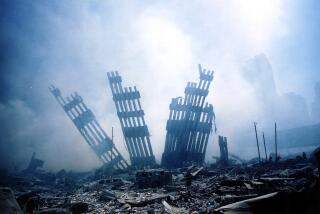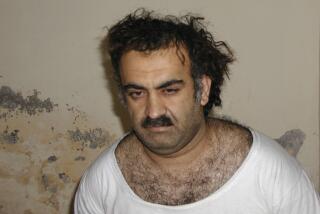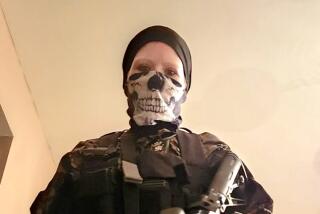Once Indifferent, Saudis Allied With U.S. in Fighting Al Qaeda
RIYADH, Saudi Arabia — After years of giving tacit support and back-channel financing to Islamic extremists, the Saudi government has joined forces with the United States in an intensive battle against Al Qaeda in the desert kingdom.
For the last year, U.S. intelligence analysts have been sitting side by side with their Saudi counterparts at a secret location here in the capital, sharing raw intelligence and plotting counterattacks, said a former U.S. ambassador to the country, Robert Jordan, and a senior Saudi government official.
Even critics who accuse the Saudis of turning a blind eye to militant Islamic terrorism in the past -- and who remain skeptical about the extent of their cooperation -- agreed that Saudi security forces were taking the Al Qaeda threat seriously and responding forcefully.
The government’s abrupt change of strategy came after a string of suicide bombings, shooting rampages and a beheading by the Al Qaeda terrorist network in Saudi Arabia in the last 15 months. The strikes have killed more than 100 people, most of them foreigners, and have threatened to cause political instability for the world’s largest oil producer.
Since suicide bombers struck three Riyadh housing compounds in May 2003, police and soldiers have killed more than 40 suspected extremists and tightened security in the kingdom. The Saudi security forces, with little experience combating sophisticated extremist organizations, have relied heavily on help from U.S. intelligence agencies, spy satellites and the FBI, Saudi and U.S. officials said.
But just as the Saudi government has shifted its strategy, so has Al Qaeda. In a bid to expand its influence and win recruits from a vast pool of Saudis who have long chafed under the repressive monarchy, Al Qaeda operatives have been switching their emphasis from killing foreigners to assassinating a member of the royal family, people close to the terrorist group and Western intelligence officials said.
These sources described the assassination plans, posted on an Al Qaeda website in June, as the next phase in the group’s ruthless campaign to topple the government and impose a strict Taliban-like theocracy.
“Many people are saying the jihadis are doing a big mistake by targeting foreigners,” said Saad Fagih, a prominent Saudi dissident in London with ties to the radical community. “They should have targeted the royal family long ago. We would admire jihadis if they would attack the royal family rather than these compounds.”
Saudi officials dismissed the threat as desperate propaganda. They said their crackdown, including the killing of three consecutive leaders of Al Qaeda in Saudi Arabia, left the group too weak to mount an attack as elaborate as an assassination.
“They try to show themselves as a very strong organization capable of doing anything they want,” Brig. Mansour Turki, a counter-terrorism expert with the Interior Ministry, said in an interview. “We are not worried at all.”
U.S. intelligence officials and terrorism experts, however, cautioned that Al Qaeda remained entrenched in Saudi Arabia and capable of staging major attacks, including an assassination of a senior member of the royal family.
The dominance of the royal family in Saudi Arabia cannot be overstated. Although there are as many as 10,000 princes, a select few control every aspect of government in the kingdom.
The unrelenting violence and the new threat of assassinations mean that the royals face an unprecedented threat from a homegrown brand of violent Islamic extremism at the same time that they confront pressure from disaffected segments of the population and U.S. demands for democratic reforms.
“The mood is terrible throughout the country,” said Mai Yamani, a Saudi expert at London’s Royal Institute of International Affairs. “You have the usual censorship and corruption. Now there is this fear. The situation is very fragile.”
Tensions are evident in Riyadh. Khaki-clad soldiers sit atop armored vehicles in the heat outside the big hotels and shopping malls. Security guards stop vehicles entering public garages, popping hoods and trunks to look for explosives. Checkpoints dot the capital’s avenues.
Western diplomats are confined largely to the well-guarded diplomatic quarter on the outskirts of Riyadh, and foreign workers tend to stick close to their housing compounds.
“This has never been a welcome place for Westerners, but now it’s like a siege,” said a diplomat who has spent two years in Riyadh.
In the late 1990s, the Saudis rebuffed American pleas for help in going after the support network in the kingdom that nurtured Saudi-born Osama bin Laden and his Al Qaeda network.
The Saudis preferred to see Bin Laden as a symbol of Islamic fundamentalist anger directed at other regimes rather than a threat to its own stability, despite his repeated condemnations of the royal family for defiling the kingdom by opening it to U.S. troops.
A U.S. official who went to Riyadh during that period to seek help tracking the money trail to Al Qaeda said the Saudi government’s response was, “Would you like another cup of tea?”
Even after the Sept. 11, 2001, attacks, in which 15 of the 19 hijackers were Saudis, the Saudi government’s response was less than complete, said current and former U.S. intelligence agents and other officials.
“The Saudis withheld so much information about the hijackers and financing of Al Qaeda that you wonder if there was a conspiracy,” Robert Baer, a former CIA agent and author of a book that criticizes the Saudis, said in an interview.
The final report issued last month by the U.S. commission that investigated the Sept. 11 attacks said the panel had found no evidence that the Saudi government or senior Saudi officials financed Al Qaeda. The report left open the likelihood that charities with “significant Saudi government sponsorship diverted funds” to the group.
Jordan, the former ambassador, described relations with the Saudis after Sept. 11 as “professional, polite and correct, but not proactive. They didn’t share everything, and we didn’t share everything.”
The situation changed May 12, 2003, when three nearly simultaneous suicide bombs gutted three housing compounds for foreigners in Riyadh. At least 35 people were killed, including nine Americans.
“For Saudis, May 12 was sort of like Pearl Harbor was for us,” Jordan said. “It took something as personal to get the Saudis involved in this war.”
Sporadic bombings and deadly clashes between militants and police followed, bringing effusive praise for Al Qaeda on extremist websites. But an explosion Nov. 8 in Riyadh that killed at least 17 people -- most of them Muslims -- tarnished Al Qaeda’s image among its backers, and the group soon shifted to targeting foreign oil workers.
Seven oil workers were killed in western Saudi Arabia on May 1, and at least 22 more -- including eight whose throats were cut -- died in Khobar on May 29. In June, Al Qaeda-linked militants seized and beheaded U.S. engineer Paul M. Johnson Jr.
“Al Qaeda has been very adaptable, and its psychological warfare has elevated over the least year,” said Magnus Ranstorp, director of the Center for the Study of Terrorism and Political Violence at the University of St. Andrews in Scotland. “Nobody knows where this could lead.”
Saudi authorities pointed to arrests, seizures of arms caches and the breakup of several plots in recent months as evidence that they were winning what one official called “war to the death.”
Much of that war is now being fought in a “fusion cell” in a suite of offices at the hidden location in Riyadh.
That is where Jordan and the senior Saudi official described analysts from the CIA, Pentagon and National Security Agency working alongside Saudi analysts. They listen simultaneously to intercepted phone conversations and jointly plan and evaluate interrogations of suspects.
U.S. surveillance drones and spy satellites track suspected militants, identify staging areas and watch for weapons being smuggled across the southern border with Yemen.
“Big flow charts are on the walls, mapping out links from interrogations, phone calls and other intelligence,” the Saudi official said.
Saudi officials are reluctant to describe the extent of the cooperation with the U.S. because they fear it could lead to more anti-government sentiment. Al Qaeda uses accusations that the Saudi government is doing the bidding of Washington to try to rouse support.
“This summer we are going to see the last of Al Qaeda in the kingdom,” said Jamal A. Khashoggi, an advisor to Prince Turki al Faisal, the Saudi ambassador to Britain.
Few others are willing to make such bold predictions, given Al Qaeda’s resilience and potential pool of recruits.
The Sept. 11 panel said in its report that Khalid Shaikh Mohammed, the accused mastermind of the attacks, told CIA interrogators that 70% of the men trained at Al Qaeda camps in Afghanistan were Saudis.
U.S. intelligence estimates that 10,000 to 20,000 men passed through the camps, creating a large number of possible operatives who can blend in with their countrymen.
Saudi security officials said they did not know how many veterans of the Afghan war went to or returned from the camps. “Nobody was stamping passports in Afghanistan,” said Turki, the counter-terrorism officer.
A new generation of fighters also is being created. Young Saudis are going to Iraq in large numbers to join the fighting, according to U.S. and European intelligence agencies. Funerals have been held in Saudi Arabia for several young men who died in Iraq in recent weeks.
“They will use these rear bases in Ramadi and Fallouja as training camps for people who will eventually return to Saudi,” said Baer, the ex-CIA agent.
Intelligence officials, who spoke on condition of anonymity, said plans to assassinate a senior member of the Saudi royal family were hatched by Abdulaziz Muqrin, an Al Qaeda leader killed in a shootout June 18.
Earlier that month, the group posted on a website affiliated with Al Qaeda detailed plans for killing Prince Nayif ibn Abdulaziz, the powerful Saudi interior minister. The plans described Nayif’s daily routine and identified his residences and the way his car is concealed among other cars in his motorcade.
“The movement of the procession: It blocks off the roads and they drive the target car in the midst of the procession with similar cars possibly to provide a camouflage procession,” said a translation from Arabic by Northeast Intelligence Network, a private group in the United States.
The declaration said Nayif would be killed in early June when he attended a reception, but there was no attack.
Fagih, the dissident, said the plans were not for a specific attack but to identify and publicize gaps in Nayif’s security as part of the next phase of Al Qaeda’s strategy.
A thin, soft-spoken physician with a black beard, Fagih tended to wounded Muslims at a hospital in Peshawar, Pakistan, in the 1980s during the war to oust the Soviets from Afghanistan.
He opposes the monarchy but does not support violence and is not a member of Al Qaeda, Fagih said. He gets most of his information from sources within the Saudi government, he said.
Saudi government officials have a different view. Turki and a second senior Saudi official said Fagih was a spokesman whose precise information about Al Qaeda’s activities indicated his closeness to the group.
Most outside analysts describe Bin Laden’s disciples in Saudi Arabia as a loose-knit group of small cells that plan and carry out attacks with a high degree of independence.
But Fagih portrayed Al Qaeda in Saudi Arabia as a more cohesive operation than outsiders imagined. He said it was best understood as three concentric circles. The inner circle contains a few dozen veterans of conflicts in Afghanistan, Bosnia-Herzegovina and Chechnya who plan and execute attacks. Its leaders are in direct contact with senior Al Qaeda members outside the country, he said.
The core group receives logistical and financial support from a wider circle of several thousand Saudis, many of whom also fought in Afghanistan and elsewhere. That second circle also runs the websites that spread the group’s message.
The widest circle, he said, is made up of sympathizers who provide shelter and emotional backing. He offered no estimate of their numbers, but a CIA assessment last year speculated that 10,000 Saudis could be supporting Al Qaeda.
Intelligence officials and outside analysts estimate that Al Qaeda has 500 to 1,500 hard-core activists, a small number in a country with an indigenous population of about 20 million.
“If the jihadis succeed in getting one of the royals, people will join them in the thousands,” Fagih predicted.
Assessing the effect of an assassination in the current climate is a speculative venture. Observers have long predicted the fall of the House of Saud, yet its princes have managed to hold on to virtually absolute power.
“If somebody succeeds in killing a high-level Saudi royal, it’s a big political deal, but I don’t think it causes the Saudi government to unravel,” said Andrew Winner, a Mideast expert and professor of strategic studies at the Naval War College in Newport, R.I.
Some experts argue that the situation is more fragile today because of the multiple pressures confronting Crown Prince Abdullah, the de facto ruler, and the other princes.
In addition to repeated extremist attacks, they face a potential backlash from fundamentalists as they try to soften the virulent anti-Western strain in Saudi religion by silencing the fieriest clerics.
On the other side of the coin, they must satisfy demands for greater democracy from moderate Saudis and the U.S. without stirring up more resentment among religious conservatives and pushing them into the Al Qaeda camp.
Finally, they must contend with people angered by widespread corruption and double-digit unemployment, particularly among the 70% of the population younger than 30.
No one expects a single assassination to topple the government. The darkest scenario -- envisioned by Fagih and described as possible by a European intelligence expert -- is that killing a senior royal would touch off a series of events that emboldens Al Qaeda, widens its support and eventually leads to a broader uprising.
“The worst nightmare is that the royal family falls and a Taliban-like regime comes in,” said Jordan, the former U.S. ambassador.
*
(BEGIN TEXT OF INFOBOX)
Terror in kingdom
Islamic extremists have killed scores of Westerners and Muslims in Saudi Arabia in a little more than a year, but they might switch tactics and target a member of the Saudi royal family. A look at the attacks:
2003
May 12: Suicide bombings at three Riyadh housing compounds kill nine Americans and at least 26 others.
Nov. 8: Suicide bombing at a Riyadh housing compound kills at least 17 people, most of them Muslims.
2004
April 21: A suicide car bomber attacks a police headquarters in Riyadh, killing at least six people.
May 1: Gunmen kill seven oil workers in an attack on the offices of a Houston-based company in the western port city of Yanbu.
May 22: Gunmen kill a German national in Riyadh.
May 29: Gunmen shoot up oil industry compounds in Khobar, killing at least 22.
June 6: A BBC cameraman is killed and a reporter is wounded in a shooting in Riyadh.
June 8: Robert C. Jacobs, an Illinois native who helped train the Saudi national guard, is shot to death at his home in Riyadh.
June 12: American Kenneth Scroggs is fatally shot in Riyadh.
June 18: Lockheed Martin engineer Paul M. Johnson Jr. of New Jersey, kidnapped six days earlier in Riyadh, is beheaded.
Sources: BBC; Saudi-U.S. Relations Information Service; Times research
Los Angeles Times
More to Read
Sign up for Essential California
The most important California stories and recommendations in your inbox every morning.
You may occasionally receive promotional content from the Los Angeles Times.










